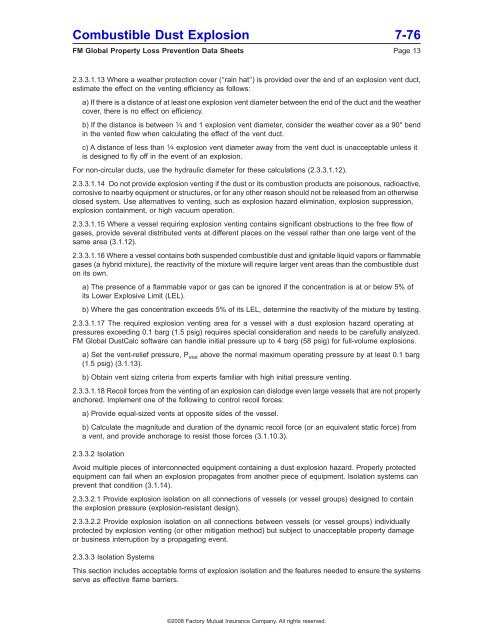DS 7-76 Prevention and Mitigation of Combustible Dust ... - FM Global
DS 7-76 Prevention and Mitigation of Combustible Dust ... - FM Global
DS 7-76 Prevention and Mitigation of Combustible Dust ... - FM Global
You also want an ePaper? Increase the reach of your titles
YUMPU automatically turns print PDFs into web optimized ePapers that Google loves.
<strong>Combustible</strong> <strong>Dust</strong> Explosion 7-<strong>76</strong><br />
<strong>FM</strong> <strong>Global</strong> Property Loss <strong>Prevention</strong> Data Sheets Page 13<br />
2.3.3.1.13 Where a weather protection cover (‘‘rain hat’’) is provided over the end <strong>of</strong> an explosion vent duct,<br />
estimate the effect on the venting efficiency as follows:<br />
a) If there is a distance <strong>of</strong> at least one explosion vent diameter between the end <strong>of</strong> the duct <strong>and</strong> the weather<br />
cover, there is no effect on efficiency.<br />
b) If the distance is between 1 ⁄4 <strong>and</strong> 1 explosion vent diameter, consider the weather cover as a 90° bend<br />
in the vented flow when calculating the effect <strong>of</strong> the vent duct.<br />
c) A distance <strong>of</strong> less than 1 ⁄4 explosion vent diameter away from the vent duct is unacceptable unless it<br />
is designed to fly <strong>of</strong>f in the event <strong>of</strong> an explosion.<br />
For non-circular ducts, use the hydraulic diameter for these calculations (2.3.3.1.12).<br />
2.3.3.1.14 Do not provide explosion venting if the dust or its combustion products are poisonous, radioactive,<br />
corrosive to nearby equipment or structures, or for any other reason should not be released from an otherwise<br />
closed system. Use alternatives to venting, such as explosion hazard elimination, explosion suppression,<br />
explosion containment, or high vacuum operation.<br />
2.3.3.1.15 Where a vessel requiring explosion venting contains significant obstructions to the free flow <strong>of</strong><br />
gases, provide several distributed vents at different places on the vessel rather than one large vent <strong>of</strong> the<br />
same area (3.1.12).<br />
2.3.3.1.16 Where a vessel contains both suspended combustible dust <strong>and</strong> ignitable liquid vapors or flammable<br />
gases (a hybrid mixture), the reactivity <strong>of</strong> the mixture will require larger vent areas than the combustible dust<br />
on its own.<br />
a) The presence <strong>of</strong> a flammable vapor or gas can be ignored if the concentration is at or below 5% <strong>of</strong><br />
its Lower Explosive Limit (LEL).<br />
b) Where the gas concentration exceeds 5% <strong>of</strong> its LEL, determine the reactivity <strong>of</strong> the mixture by testing.<br />
2.3.3.1.17 The required explosion venting area for a vessel with a dust explosion hazard operating at<br />
pressures exceeding 0.1 barg (1.5 psig) requires special consideration <strong>and</strong> needs to be carefully analyzed.<br />
<strong>FM</strong> <strong>Global</strong> <strong>Dust</strong>Calc s<strong>of</strong>tware can h<strong>and</strong>le initial pressure up to 4 barg (58 psig) for full-volume explosions.<br />
a) Set the vent-relief pressure, P stat above the normal maximum operating pressure by at least 0.1 barg<br />
(1.5 psig) (3.1.13).<br />
b) Obtain vent sizing criteria from experts familiar with high initial pressure venting.<br />
2.3.3.1.18 Recoil forces from the venting <strong>of</strong> an explosion can dislodge even large vessels that are not properly<br />
anchored. Implement one <strong>of</strong> the following to control recoil forces:<br />
a) Provide equal-sized vents at opposite sides <strong>of</strong> the vessel.<br />
b) Calculate the magnitude <strong>and</strong> duration <strong>of</strong> the dynamic recoil force (or an equivalent static force) from<br />
a vent, <strong>and</strong> provide anchorage to resist those forces (3.1.10.3).<br />
2.3.3.2 Isolation<br />
Avoid multiple pieces <strong>of</strong> interconnected equipment containing a dust explosion hazard. Properly protected<br />
equipment can fail when an explosion propagates from another piece <strong>of</strong> equipment. Isolation systems can<br />
prevent that condition (3.1.14).<br />
2.3.3.2.1 Provide explosion isolation on all connections <strong>of</strong> vessels (or vessel groups) designed to contain<br />
the explosion pressure (explosion-resistant design).<br />
2.3.3.2.2 Provide explosion isolation on all connections between vessels (or vessel groups) individually<br />
protected by explosion venting (or other mitigation method) but subject to unacceptable property damage<br />
or business interruption by a propagating event.<br />
2.3.3.3 Isolation Systems<br />
This section includes acceptable forms <strong>of</strong> explosion isolation <strong>and</strong> the features needed to ensure the systems<br />
serve as effective flame barriers.<br />
©2008 Factory Mutual Insurance Company. All rights reserved.

















